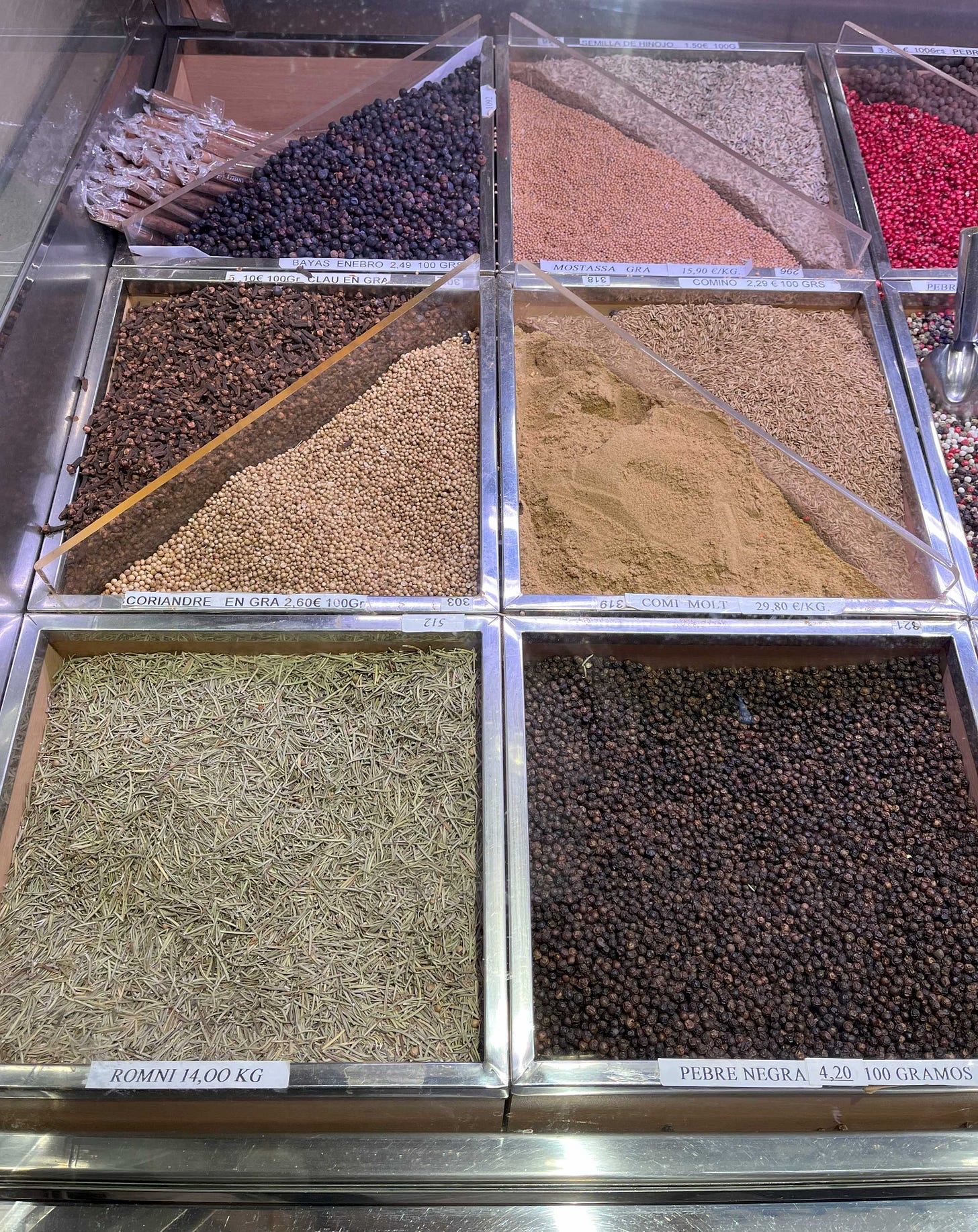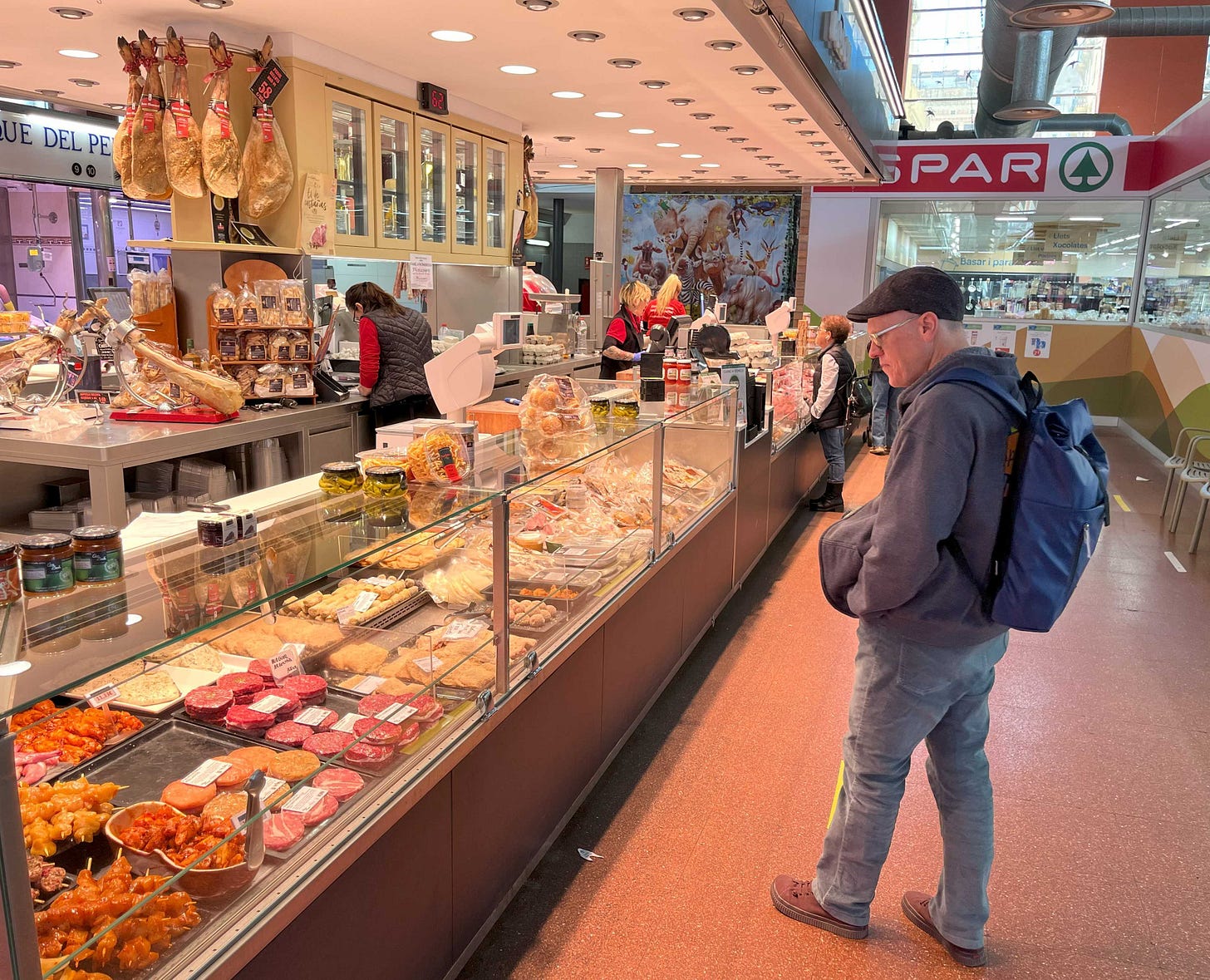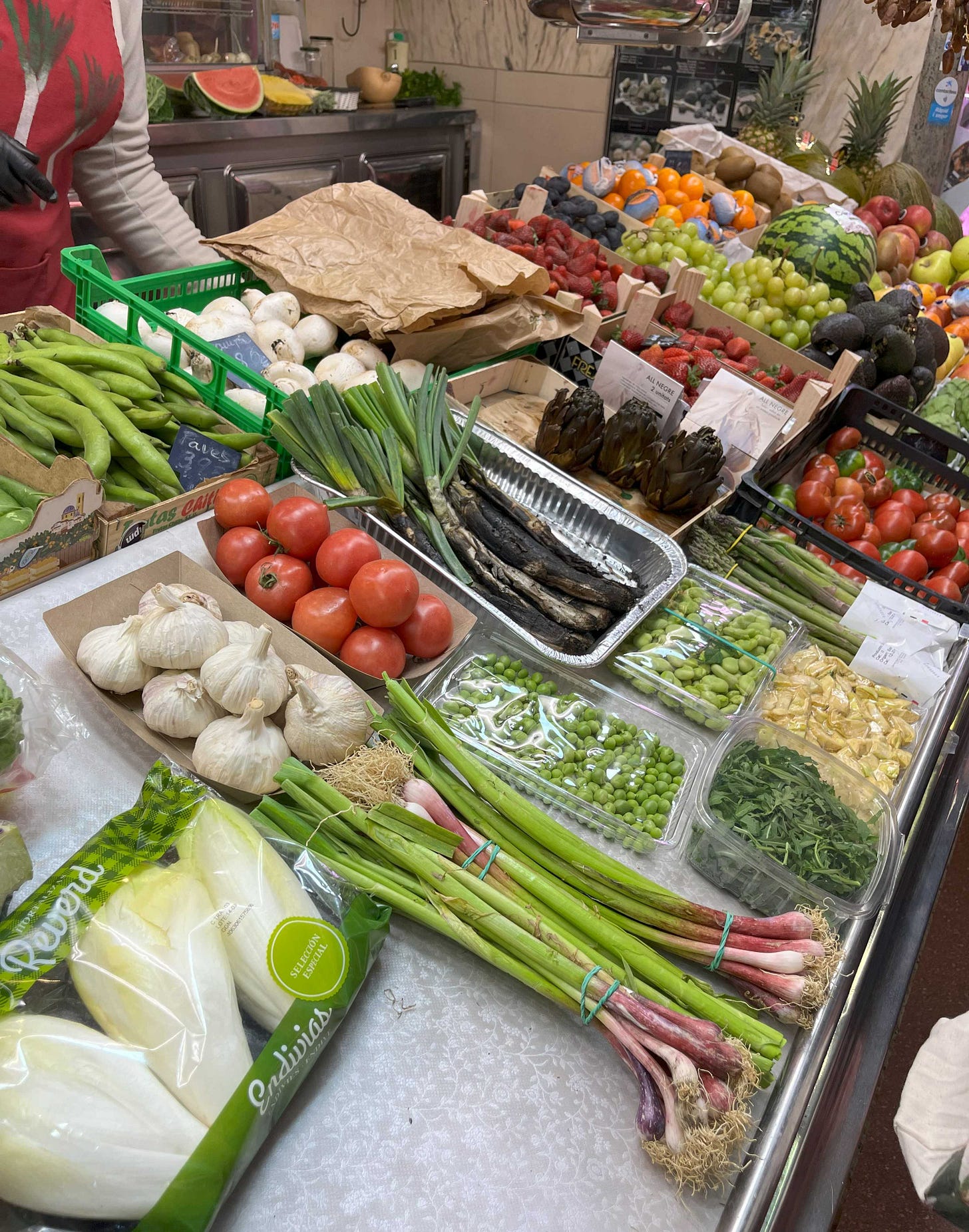Barcelona is not unlike much of the rest of Europe in August. Aside from the tourists, there are fewer crowds, as the locals have headed out of town to less hectic, perhaps more distant and maybe somewhat cooler locales. Conversely, I’ve heard more French spoken over the last few weeks as they and other Europeans take advantage of their extended vacation time. The Americans in town, including our visiting friends and relatives, have been fortunate to enjoy the city in a more relaxed state.
Unless, like us, they’ve found that the restaurants or shops they’ve planned to visit are closed. For Americans, it can strike us as a bit odd or even annoying to some, to see that a business establishment will close sometimes for more than an entire month in the summer for vacation. Rumor has it, though, that this was not uncommon “back in the day” in Phoenix and Tucson between Memorial Day and Labor Day. In those days, permanent residents could usually get discounts from the resorts and spas that remained opened. Plus, there were advantages to fewer crowds at pools and golf courses when it wasn’t as brutally hot as in the summer as it is now.
While we’ve seen closings in Barcelona with restaurants and shops, doctor’s offices and pharmacies will close for extended periods as well. Usually, the proprietor will post an announcement, but it can also be word of mouth which you might only know if you’re a regular customer. For us, it hasn’t been much of an impact but gives us a chance to try other bistros and tiendas. It is disheartening, however, that our regular butcher or greengrocer is not available, although in the summer, who feels like cooking? Nevertheless, there remains the option that has stayed open throughout the summer and that Barcelona is best known for: its market halls.
In spite of my ingrained disdain for food shopping, in Barcelona it wasn’t long before I looked forward to it. Generally I have really disliked going to the supermarket. The thought of stepping into cavernous and generally cold monstrosities of warehouse-like buildings filled me with dread. It could be my unpleasant memories of working in a grocery store during my undergraduate years. During the COVID pandemic, I found that even a mildly stressful trip to go food shopping was made worse by the irritable shoppers and temperamental staff. I tried to be sympathetic, but these weekly public encounters stretched my already limited patience. It wasn’t long before my husband and I came upon an ideal solution to this weekly inconvenience: we could order groceries on either the Fry’s or Safeway app in the comfort of our home and pick up groceries at our leisure. Outstanding idea, I was sold! Of course, the process wasn’t always perfect and there were errors with our orders but overall, it was mostly convenient. Sometimes we had to make an extra trip to Whole Foods or Sprouts if we needed a specialty item, but it was generally a quick trip. Yet, it was still time that could be better spent doing other things.
For a change of pace, Les and I would occasionally shop at one of the farmer’s markets in the Phoenix area. We had a couple of favorites but enjoyed shopping at the Uptown Farmer’s Market, especially on Wednesdays. Mostly we liked soaking up the atmosphere, especially since we could bring our dog Farrah along. The crowd seemed friendly enough as we moved up and down the rows of produce, food trucks and craft stalls. Nevertheless, these instances were more the exception rather than the rule. Additionally, the farmer’s markets tended to focus more on presentation and making one’s visit, an event rather than simply a regular occurrence. I also noticed that there’d be a considerable number of out of town visitors (we’ve even brought some of our guests).
Mercat de la Boqueria in the El Raval neighborhood of Barcelona
On a previous trip to Barcelona two years ago, we explored La Boqueria, the city’s largest food hall. We were fascinated by the lavish displays of produce and meats (Les was particularly enamored by the jamón selection). Everything was arranged neatly and precisely. The colors of the items appeared to be organized in a deliberate and artistic fashion. Unlike the farmer’s markets in the US, the market sold mostly food items, no craftspeople or artists in sight. We also noticed bars and restaurants lining the periphery. If this is what grocery shopping was like in Barcelona, we’d be here every day.
However, we realized that La Boqueria has been promoted as a tourist destination1. While it’s true that local residents shop there, many tourists consider it to be a “must see attraction”2. Any time spent shopping there would incur battling hordes of visitors taking selfies, disrupting the regular customers buying their daily provisions. This is an unfortunate, not only for us but for the surrounding neighborhood of El Raval, a largely working class and immigrant community that sees the market as its lifeblood. Our disappointment would pale in comparison to the of the locals and the vendors if we focused solely on La Boqueria. We quickly discovered that there were other alternatives to La Boqueria.
Barcelona boasts nearly 40 market halls3. The markets are housed in permanent structures that vary in size. This is much different from most of the markets in the United States that are scattered throughout many metropolitan areas and are provisionally situated on parking lots and vacant parcels of land. They operate at least six days of the week, unlike farmer’s markets in the US which tend to operate just once or twice a week. This network of markets came about through a combination or fate, food trends, and policy. Although markets were viewed as anachronistic by the 1950s, Spain’s economy remained underdeveloped. Commercial food distribution was fragile4. This led to a reliance on the market halls to bolster the system5. After the regime of Francisco Franco, Catalan nationalism flourished. The renewed emphasis on the use Catalan language went hand-in-hand with the revival of Catalan cuisine as “component[s] of [Catalan] identity”6. Newfound recognition of Catalan dishes also coincided with the emergence of “market cuisine” i.e., the which prioritized working with fresh ingredients procured at local markets in the 1980s7. Coupled with Barcelona’s function as a major world port, the city is unique compared to others in Europe that have seen the number of food halls decrease over the last several decades8. More importantly, the city of Barcelona bucked the trend towards deregulation of commerce and implemented a plan to reimagine the role played by the markets9. This has led to the current situation of a preponderance of public food halls located throughout the city.
Given the abundance of food markets and their accessibility, it shouldn’t be difficult to find a suitable one where we can shop on a regular basis. If they had nearly half the selection of La Boqueria, we’d consider ourselves fortunate. La Boqueria is the largest of the markets10 but not the most practical place to shop. Its size, location and renown are what make it one of Barcelona’s prime tourist attractions. Since moving here, we’ve only visited once and only because they were one of the few markets that were open after three PM.
In our treks across town, we usually encounter a market hall in the vicinity. Any one of them would be more than sufficient to serve our needs at any given time. During a recent walking tour of Barcelona’s El Raval neighborhood, our guide (and teacher), Beatriz recommended three: Santa Caterina, Sant Antoni, and Barceloneta11. We’ve yet to go to Barceloneta’s market, so I can’t give an opinion, but we’ve been to Sant Antoni and Santa Caterina. We visited Sant Antoni but didn’t stay for long. We made the mistake of going on a Saturday afternoon a week before Christmas. It was packed with shoppers scouting out ingredients for their upcoming holiday meals. I thought about purchasing a kilo or so of roasted cashews. When I took my ticket, my number was 57. On the screen above flashed number 23. We figured it would be a long wait before we were served and decided to leave and return when it wasn’t nearly as busy.
Closer to us is the Mercat de Santa Caterina located in the heart of the El Born district. We’ve visited quite a bit since we’re in the neighborhood at least once or twice a week. With its location in a heavily traveled and tourist-centric locale, the market is usually crowded on Saturday. However, we’ve gone on a weekday when there is less hustle and bustle. On one occasion, we decided to have an impromptu lunch at the Bar Sant Joan, located inside the market. Next to us were seated an American couple from Seattle. We never got their names, though, but we had a fascinating conversation and were intrigued by our move to Barcelona. We gave them a few recommendations, since in their eyes, we were locals. The market also has a fine restaurant, the Kitchens of Saint Catherine (or in Catalan Cuines Santa Caterina). It was there that we had yet another meal featuring calçots and had the chance to impress the staff with our eating skills.

An Assortment of the Herbs and Spices Available at Santa Caterina
Another market that we’ve taken a liking to is the Mercat de la Concepció (La Concepció Market). It’s close to the English language bookstore that is quickly becoming our expat hangout. The market is small compared to Sant Antoni and Santa Caterina, but they have a diverse selection of goods plus a flower market/nursery called Flors Navarro in the front. Les and I purchased a few plants to brighten our balcony for the spring. Outside of the market is a restaurant, Casa Amàlia, which as is usually the case, Les and I stumbled upon when deciding where to have lunch. The food was great, and the staff could not have been friendlier or more helpful and even encouraged us to use Spanish. We brought Les’s aunt and uncle there for lunch when they were in town recently and the staff were delighted that we returned. Earlier this summer, we treated our niece, her husband and daughter to dinner to celebrate her husband’s birthday. It was yet another memorable meal!
The Many Colors of La Concepció Market
The Clot neighborhood is just a few metro stops away but it’s a pleasant barrio that we discovered when we needed to pick up a package at the post office. There is a food hall in that area that while it is not as sprawling as some of the other markets, the staff are rather accommodating, and their selection of produce and meats is varied. In the spring, we stopped there with no dinner plans and hoped for inspiration. We easily found it! The fresh pasta vendor cheerfully advised us on his selection of ravioli. The breezy produce vendor was selling grilled calçots, so needless to say, we had to have them before they were gone. It was only the second time we shopped at that market, but we had to go back the next day for that night’s dinner. Mercat del Clot is definitely on our list of favorites.
Finding Dinner at Mercat del Clot
Hmm, What Looks Good?
At That Price, Give Me the Whole Case!
We Should Get Some Calçots a la Plancha Before They’re Gone For the Season
It's easy to be overwhelmed while shopping at the public food markets. There are three supermarkets in our neighborhood that we also patronize. We also frequent several of the specialty shops in our neighborhood as well as I alluded to earlier. These include a local fishmonger (pescadería), butcher (carnicería) and several greengrocers (verdulerías). From what I’ve observed so far, there is a system in place that is understood by the locals, especially those who frequent the same markets and smaller shops. The customers seem to be on familiar terms with the vendors. Just as an example, once at the Clot Market, while we waited to buy our calçots, the vendor was filling an order for a customer. The customer was rather talkative and engaged in an animated conversation with two friends. The clerk was patient as she expected the patron to resume her order, yet she continued to chat. The vendor gave us a knowing look and allowed the shopper to continue with her story but took care of us in the interim. The unsaid rule seemed to be “pay attention, place your order, or I’ll wait on someone else.” Nevertheless, there was a geniality about the situation. It made me feel as if we were part of the ingroup, even if it was brief. We were important, not to be ignored. That moment gave me a sense of belonging. Even though it might seem as if the merchants and their clientele appear to be a closed group, newcomers might just be welcomed into the fold. The unwritten rituals of the market might not stay that way for long as we navigate this segment of society. We’ve had similar experiences with individual shop owners in our neighborhood and beyond. However, that will be a discussion for a future essay.
As the summer winds down and cooler weather is around the bend, we look forward to the re-opening or our familiar tiendas and restaurants. Despite the closures, we know that the markets will be open for us and the rest of the city and providing all the necessary culinary essentials.
Works Cited
1,2Crespi-Vallbona, Montserrat, and Darko Dimitrovski. “Food Markets from a Local Dimension – La Boqueria (Barcelona, Spain).” Cities, vol. 70, 2017, pp. 32–39, https://doi.org/10.1016/j.cities.2017.06.011.
3,10Ciolli, Chris. “Here Are Barcelona’s Best Markets and Everything to Eat in Them” Eater, 26 October 2021, https://www.eater.com/22621306/barcelona-markets-guide-boqueria-where-to-eat.
4-9Garcia-Fuentes, Josep-Maria, et al. “Reinventing Edible Identities: Catalan Cuisine and Barcelona’s Market Halls.” Edible Identities: Food As Cultural Heritage, 1st ed., Routledge, 2014, pp. 159–74, https://doi.org/10.4324/9781315578781-11.
11Cejudo-Gumiel, Beatriz. “Walking Tour: Barceloneta.” Sponsored by World Class Barcelona Language School, 14 February 2024, Barcelona, Spain.











